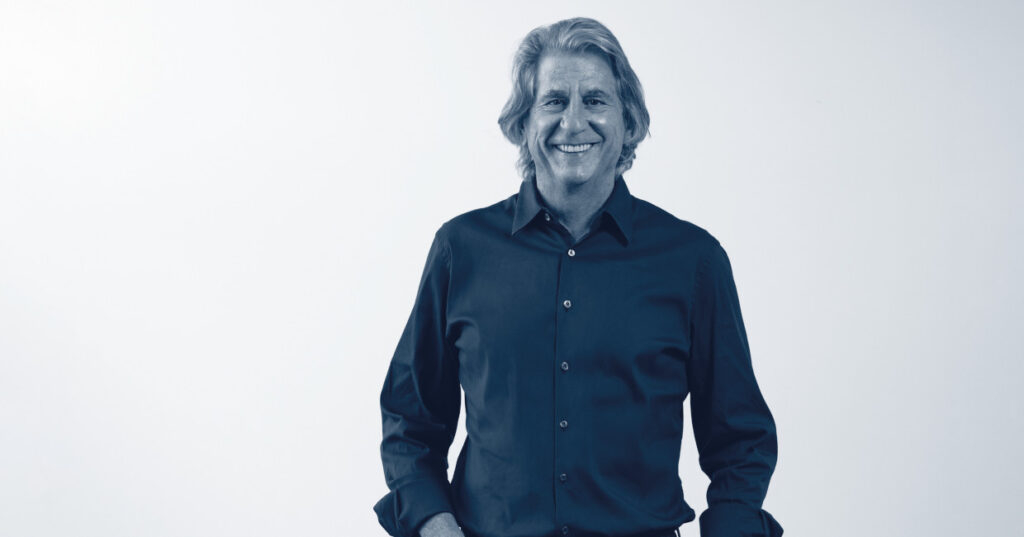Approaching Rockwell Group’s 40th anniversary, Sophie Harper touched base with the studio’s founder and all-round industry megastar David Rockwell to find out how being influenced by the theatre and having an innate understanding for human connection have stood the studio in good stead.
Hailed as design royalty, it’s easy to see when looking back over his career history why the heavily awarded David Rockwell is held in such high regard. A design maverick, David has managed to merge worlds taking inspiration from the theatre to create spaces and products that fascinate and delight, which he has been doing successfully with his studio, Rockwell Group, for 40 years.
“My mother was a dancer and choreographer and ran a community theatre on the Jersey Shore. She often cast me in productions,” David tells me. “Seeing how art and beauty were created through collaboration was completely eye-opening. That might have been the first clue that the power of shared experiences in the public realm would be a passion of mine, but I didn’t realise it was a career path.”
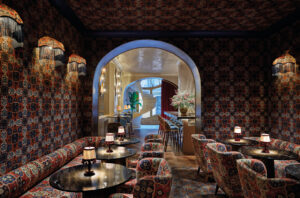
When he was 11, David’s family took him to New York City for the first time to see Fiddler on the Roof on Broadway and to dine at Schrafft’s. “It was the first time I connected theatre and restaurants as vehicles to bring people together and create instant communities,” he says. “It was also the first time I made the connection between design that was manipulated and performative, in terms of the set, and narrative – I saw how the design of Fiddler on the Roof helped propel the story and convey emotion. Since then, I’ve been fascinated by design as a tool for facilitating connection through shared experience, and design as a storytelling tool.”
He tells me the desire to make things and collaborate with others started at an early age. “As a child dealing with a lot of transitions, like moving to different cities and countries, I gravitated towards building toys – Tinker Toys, Lincoln Logs and building blocks. Being able to create things allowed me to have control over something and mediate the world.”
David studied at Syracuse University in New York where he received his Bachelor of Architecture degree before taking further studies at the Architectural Association in London. Returning to New York, he founded Rockwell Group in 1984 – just five years after graduating. “I knew I didn’t want to be confined to a particular design type. However, expertise in certain project types emerges as you grow organically, such as our hospitality work. Today, we are a 300-person studio with satellite offices in Los Angeles and Madrid. As we move into our 40th year, we have sharpened our ability to break the siloes of expertise to keep public spaces feeling fresh, authentic, relevant, and whole. Bringing people together and creating spaces that come alive when occupied has always been at Rockwell Group’s core.”
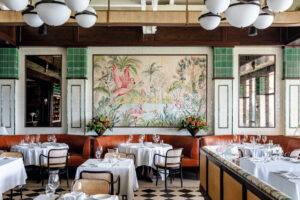
One of the most versatile design studios on the planet, Rockwell Group is known for a plethora of design projects, not just hospitality, but residential, product, healthcare, and (unsurprisingly) set design for the theatre. He tells me how he finds inspiration for such a wide range of projects everywhere. “We are research junkies wanting to understand every facet of a problem, or material or business before we even begin to think about a solution, and often inspiration comes from research. Overlaid with research are our obsessions around how things are made and how materials are used, combined, or even invented.
I am inspired by anything that I emotionally connect with, be it the work of an artist, the food of a chef, or a beautiful piece of music, a walk with a friend or a colleague, or a trip to another country.
“Inspiration then often leads to the narrative in a project, which is essential. Theatre introduced me to the power of ideas and the multiple ways those ideas could be expressed: a single script, screenplay or libretto, all driven by a narrative, can be expressed in infinite ways. Every project offers an opportunity to invent a language. Design at its core is an exhilarating journey that should have a destination with impact, where knowledge and intuition weave together to create a new fabric every time.”
David explains that one of the biggest challenges designers face is finding the right balance for people to experience public and private spaces, and striking the right chord to encourage person-to-person interaction. “I care about how my design is experienced, not theorized, but how it is felt ‘on the ground’ on an average day. For me, design has to be accessible, easily understood either directly through some form of reasoning or emotionally as something felt. I think design has to communicate the idea that it underpins; a backstory gives it a reason to be, and an intelligence that has gathered a myriad of forces to conjure something more than the sum of its parts. Perhaps more than anything I think design should be memorable.”
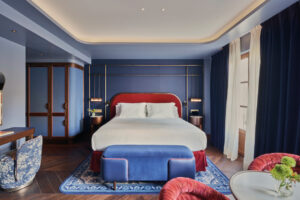
Describing the makeup of the Rockwell Group team as being a design city made up of skilled designers, model makers, coders, strategists, material librarians and more in each office location, he says their output is collective and collaborative. “My focus has always been on uncovering opportunities in every project, to make a difference, make something that hasn’t been done, to make something new, regardless of scale or type. Our studio’s cross-disciplinary approach, which allows a plurality of personalities and talents to collaborate, experiment, and play enables us to come up with innovative and ground-breaking ideas for each and every project we work on. I think that desire to collaborate has had the biggest impact on our hospitality projects and helped us create narratives that resonate really deeply with guests.”
With this sentiment, David says experiential design is something Rockwell Group has been incorporating to many of its hospitality projects, speaking about their ground-breaking immersive media experience in the lobby of the Cosmopolitan in Las Vegas, which Rockwell’s ‘LAB’ created with Broadway choreographer Jerry Mitchell. “While our LAB at Rockwell Group is dedicated to merging story with architecture and technology, we also believe that technology shouldn’t be embedded into a project simply for its own sake – it has to be the only way and the right way to tell a piece of the story.
“I think of experiential design as evolving and responding to its audience and program over time, and that’s something we aim to do with all our work, whether or not it is driven by technology.” A recent example of this is the FUTURES exhibition at the Smithsonian Institution’s Arts + Industries Building in Washington, DC. David explains, “Our exhibition design featured experiential learning-based installations and immersive digital content to illustrate how particular values and priorities may shape our collective future. More than 750,000 people visited the exhibition over a nine-month period and it inspired many to co-create a better future.”
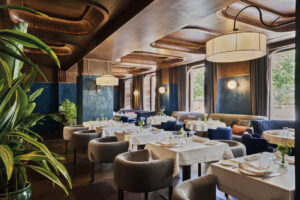
I ask David if he thinks wellness and mindfulness play an important role in hospitality design, “Absolutely,” he agrees, “and I think it goes beyond the use of healthy materials and traditional wellness programming. Holistic wellness in hospitality has to be embedded in every aspect of the design, from the way guests are choreographed through a space to the variety of seating areas offered in a lounge, to the lighting in a guest room or corridor.”
Rockwell Group is currently working on the renovation of the W Union Square in New York (which they originally designed in 2000), Fontainebleau Las Vegas, Nobu Hotel New Orleans, and several international properties throughout Spain, Portugal and Greece, and they recently completed the renovation of the historic Boca Raton resort in South Florida.
With a constant stream of projects keeping the team busy and David seemingly keen to continue as he has been doing for the last 40 years, I wonder what his secret to success is. He tells me, “I didn’t consciously plan this; I’ve just been driven by a cocktail of curiosity, restlessness and wonder. Discovery is such a powerful emotion. As a designer I need to be constantly learning, constantly making, and output and building things are much more interesting to me than speculation. This is why we often initiate projects, to explore ideas rather than wait for a client to knock on the door, and I think that – combined with working across a diverse range of typologies – has helped us to grow and remain vibrant and alive to possibility.”
Tapping into this sensibility, I ask David how we can continue to keep hospitality spaces relevant to an increasingly diverse range of people. “Our world has changed so much in the years since the pandemic, but one thing that won’t change is the importance of creating human connection through physical space,” he says. “The pandemic also made abundantly clear that architects should be at the table when it comes to approaching some of our toughest, most intractable challenges, from climate change to healthcare access, to housing. We are problem solvers and creative thinkers by training and nature. The significance and appeal of real, physical spaces has never been clearer: the rich sensory experiences they provide, and the spontaneity of the interactions they support. We have to rediscover the signature rituals or experiences we can give audiences going forward, and how to continue to create connection in ways that are meaningful, memorable, and human.”


